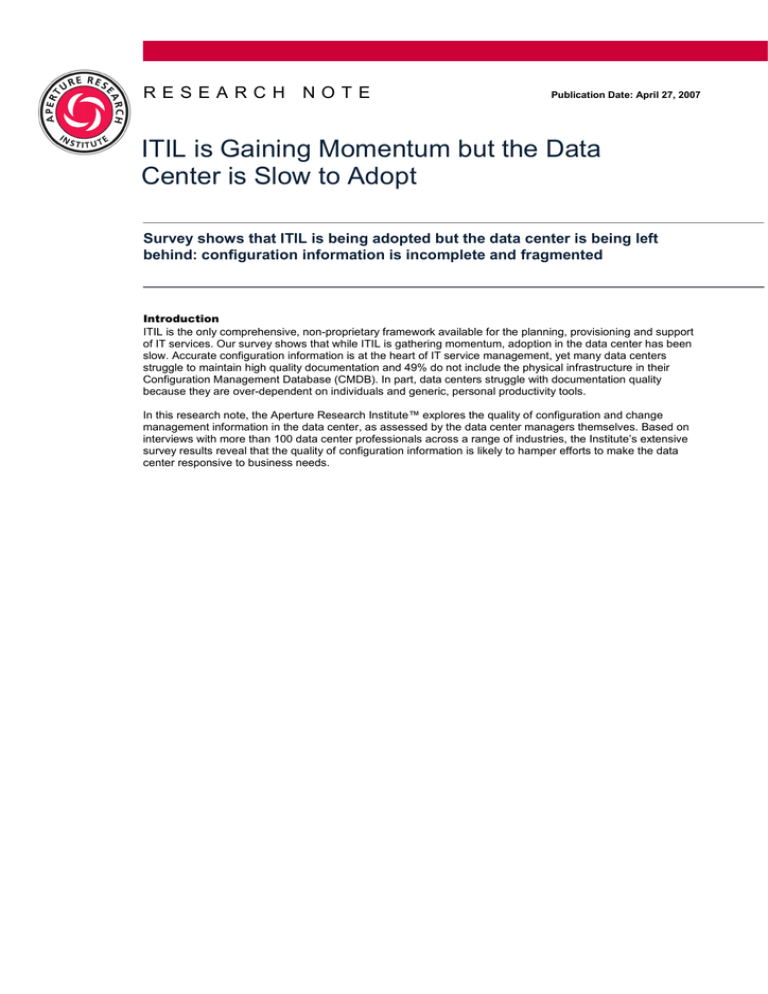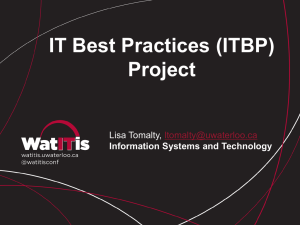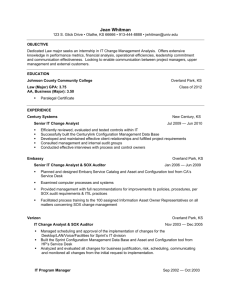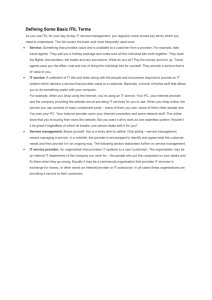
RESEARCH NOTE
Publication Date: April 27, 2007
ITIL is Gaining Momentum but the Data
Center is Slow to Adopt
Survey shows that ITIL is being adopted but the data center is being left
behind: configuration information is incomplete and fragmented
Introduction
ITIL is the only comprehensive, non-proprietary framework available for the planning, provisioning and support
of IT services. Our survey shows that while ITIL is gathering momentum, adoption in the data center has been
slow. Accurate configuration information is at the heart of IT service management, yet many data centers
struggle to maintain high quality documentation and 49% do not include the physical infrastructure in their
Configuration Management Database (CMDB). In part, data centers struggle with documentation quality
because they are over-dependent on individuals and generic, personal productivity tools.
In this research note, the Aperture Research Institute™ explores the quality of configuration and change
management information in the data center, as assessed by the data center managers themselves. Based on
interviews with more than 100 data center professionals across a range of industries, the Institute’s extensive
survey results reveal that the quality of configuration information is likely to hamper efforts to make the data
center responsive to business needs.
DATA CENTERS LACK TOOLS TO MEASURE EFFICIENCY AND SUPPORT GREEN INITIATIVES
2
Analysis
ITIL is the only comprehensive, non-proprietary framework available for the planning, provisioning and support
of IT services. Originally developed by the British government in the 1980s, it encapsulates best practice
recommendations for delivering IT services more efficiently and effectively. Its framework provides high level
guidance on how to align the IT organization with the business objectives, and how to establish management
processes across the IT organization that support networks, systems, applications and databases. Version 3 of
ITIL was published May 2007, following over a year of development.
The increase in high-density equipment is eliminating the margin for error that many data centers previously
1
had and is bringing them closer to their limits on power and cooling capacity . Best practice management of
ITIL’s Service Delivery and Service Support processes is essential to ensure optimal uptime and service
quality. At the same time, businesses are increasingly IT-dependent and data intensive, and the data center
must be closely aligned with business growth and direction. With ITIL Version 3, the link to the business
requirements is much more explicit which makes ITIL even more valuable as a tool for managing IT services
from planning through to retirement.
ITIL is continuing to gain a foothold in the market. 29% of data center managers surveyed said their
organizations had ITIL initiatives in place. A further 30% are working on introducing them and 9% are making
plans to implement ITIL. 20% said they were merely investigating ITIL and 12% confessed they were not
familiar with it.
How would you describe your organization's position on ITIL?
100%
80%
60%
40%
30%
29%
9%
20%
20%
12%
0%
Already
read
dy iin
nP
Place
lace
Worki
Working
ing tto
oR
Roll
oll
Out Now
Planning Rolling
Out
Invest
Investigating
tigatting
Not familiar with
ITIL
Our survey shows, however, that while ITIL is gathering momentum in organizations, adoption has been slow in
the data center.
At the heart of a sound ITIL strategy is the Configuration Management Database (CMDB). 74% of those
surveyed said they had a CMDB initiative, but many of the tools were improvised using generic personal
productivity software, such as Excel spreadsheets and Visio diagramming software. These tools make it harder
to roll out enterprise-wide and enforce standardization, and are difficult to integrate with other data sources in
the IT organization. They perpetuate a dependence on individuals and manual processes for maintaining
accuracy and aggregating information.
What are you using as your CMDB?
50%
40%
30%
20%
31%
21%
116%
6%
13%
10%
31%
21%
5%
0%
Excel
Ex
x c el
Visio
V is io
Or
Oracle
rac le
database
d
t b
1
In h
house
ous e
Asset
As s et
BMC
C Attirum
Attirum
developed
d l d ttools
l managementt
system
O
ther
Other
externally
t
ll
purchased
(vendor) tools
See: Data Center Professionals Turn to High-Density Computing as Major Boom Continues, Aperture
Research Institute, April 2007
©2008 Aperture Technologies, Inc
DATA CENTERS LACK TOOLS TO MEASURE EFFICIENCY AND SUPPORT GREEN INITIATIVES
3
Many of those who have a CMDB strategy (49%) admitted that they did not include physical infrastructure
components (such as power and cooling) in it. At a time when high-density equipment is becoming widespread,
the availability of power and cooling are absolute limits on data center capacity. It is particularly surprising that
data centers are not adequately documenting the physical layer of the data center, given that 54% of those
surveyed said they had experienced between one and five outages at the physical level.
If you have a CMDB, is the data center physical infrastructure included?
100%
80%
60%
49%
34%
40%
17%
20%
0%
Yes
Y
es
N
No
o
Did not answer
The use of PDUs and UPSs is among data center assets documented elsewhere. Most data centers document
the equipment they have (85%) and its location (93%), but only 64% are tracking space availability and only
55% are recording their redundant components.
Which physical infrastructure attributes do you document? (Check all that apply)
93%
Equipment location
85%
Equipment list
83%
UPS use & availability
PDU/breaker use &
availability
76%
64%
Space use & availability
Redundant components
(primary/backup)
55%
Breaker-to-server
connectivity
51%
0%
20%
40%
60%
80%
100%
For effective service management in the data center in compliance with ITIL, good configuration information is
essential. Our survey reveals that many data centers are struggling with the quality of their information. Only
8% of those surveyed were bold enough to describe their configuration information as excellent, and only 24%
considered it good. About a third (32%) thought it was average, but an equal number settled on fair and 5%
admitted configuration information was poor.
How would you describe the current state of your data center configuration information?
100%
80%
60%
40%
20%
8%
24%
32%
31%
5%
0%
Excellent
Good
Good
d
©2008 Aperture Technologies, Inc
Average
Fair
Faiir
Poor
DATA CENTERS LACK TOOLS TO MEASURE EFFICIENCY AND SUPPORT GREEN INITIATIVES
4
One reason for the lack of confidence in the configuration information could be its accuracy. If some data is
inaccurate, it is hard to have confidence in any of it, and 62% of those surveyed thought that more than 10% of
their information was incorrect. Only 38% of data center managers believe their configuration information is
over 90% accurate. About a third of the managers we surveyed thought their configuration information was
between 76% and 90% accurate, but 18% thought it was somewhere between 50% and 75% correct. As many
as 8% confessed that they can’t trust half their configuration information. The challenges will be to work out
which half is reliable when they urgently need to respond to an incident and how to account for this partial
accuracy in an report across the entire data center (such as a capacity report).
How accurate would you estimate your configuration information is?
50%
30%
18%
20%
10%
38%
35%
40%
8%
1%
0%
Less
ess T
Than
han 50%
50%
50
50-75%
0-7
75%
76
76-90%
6-9
90%
Over 9
90%
0%
No documentation
Some data centers are not making much effort to improve the accuracy of configuration information: only 30%
said they audited the accuracy of the configuration information monthly or more often. Given the rapid and
frequent change that is part of daily life in today’s data center, unchecked configuration information can quickly
fall out of step with reality. 35% said they check configuration information accuracy quarterly, and 24% check
once a year. 9% never check the accuracy of their configuration information, which makes it difficult for them
both to ensure accuracy and to have faith in the data they hold.
How often do you check the accuracy of your configuration information?
100%
80%
60%
40%
20%
9%
21%
35%
24%
9%
0%
Weekly
Monthly
Montthly
Quarterly
Quartterlly
Annually
Annuallly
Never
2%
We do not have
documentation
Inconsistencies arise when too many different systems are used to store data. 59% of data center managers
said they use between three and five different systems to document the data center infrastructure and 17% said
they use over six different systems. With so many different sources of data, it could prove difficult to react
quickly to incidents or aggregate the information in a single view. Only 6% of data center managers use a
single system to document everything.
How many different systems are used to document your data center infrastructure (equipment, space, power, cooling, network
connectivity)?
100%
80%
59%
60%
40%
20%
6%
17%
13%
4%
1%
Over 1
10
0
systems
None
0%
1 sys
system
y tem
2 systems
sys
y tems
©2008 Aperture Technologies, Inc
3-5 sys
systems
y tems
6-10
-10 sys
systems
y tems
DATA CENTERS LACK TOOLS TO MEASURE EFFICIENCY AND SUPPORT GREEN INITIATIVES
5
Data centers are still over-dependent on staff and personal productivity tools for their documentation. Using
generic tools makes it harder to standardize and also limits the organization’s ability to integrate its information
with other data sources. When configuration information is not standardized, it can make the data center reliant
on the availability of a particular staff member to access information, which could be required urgently to avert
or fix an outage. Half the data centers rely on individuals for configuration information, 69% are using Excel
spreadsheets and 54% are using Visio. 39% have developed bespoke tools and 43% are using vendor tools.
What do you use to document your data center?
100%
69%
80%
60%
51%
51%
40%
38%
54%
54%
39%
43%
18%
13%
Other,
Please
Specify
Aperture
20%
0%
Individuals
ndivviduals Auto
A
AutoCAD
oCAD
Excel
Ex
xc el
Visio
Vis io
In-house
In-h
hous e Externally
Exte
ernally
d l d purchased
h d
developed
tools
(vendor)
tools
The systems used and their multiplicity makes it difficult to update data quickly. A fifth of data center managers
said it took between one and three weeks to update configuration information, which means they can only be
confident it is accurate to three weeks ago if there is an outage. A lot can change in that time. Nearly half of
data centers (48%) take between a day and a week to update configuration information. Only 22% could
achieve an update the same day, achieving ITIL’s goal to tightly integrate change and configuration
management.
How much time does it take to update your configuration information?
100%
80%
48%
60%
40%
20%
22%
20%
5%
5%
Between 3 and 8
Weeks
More than 8 Weeks
0%
Less
ess tthan
han 1 Day
Day
Between
ween
n 1 Day
Day and
1 Week
Between
etwee
en 1 and
and 3
Weeks
As well as documenting the data center environment, good service management discipline requires change
management processes to be fully documented. Data center managers have more faith in their change
management processes than their configuration documentation, with 12% describing it as excellent, 34%
saying it was good and 38% calling it average. Only 14% thought the change management documentation was
fair and only 3% considered it poor. Change management includes equipment installs, moves and
decommissions.
How well are your change management procedures (equipment installs, moves, decommissions) documented and followed?
50%
34%
40%
38%
30%
20%
14%
12%
3%
10%
0%
Excellent
Ex
xcellent
G
Good
ood
©2008 Aperture Technologies, Inc
Average
Average
Fair
F ai r
Poor
DATA CENTERS LACK TOOLS TO MEASURE EFFICIENCY AND SUPPORT GREEN INITIATIVES
6
Although the procedures are considered to be well documented and followed, over half use email or manual
processes which do not have tight integration with their configuration information. 36% rely on email, which has
no workflow management and in effect delegates responsibility for the change without follow-up. 23% use
manual processes, which are more prone to error and which can be labor and time intensive. 40% of those
surveyed use tools developed in-house. These offer optimal flexibility only if the organization has the resources
to rapidly adapt the software in line with changes in the data center and market.
How do you manage changes in the data center?
100%
80%
60%
40%
23%
336%
6%
26%
20%
25%
40%
25%
12%
12%
0%
Manual
M
anual
processes
p
E
Email
mail
Other,
Please
R
Remedy/BMC
emed
dy /BMC Pere
Peregrine/HP
egrine/HP In h
house
ous e
O
Other
ther
therr, P
lease
Specify
developed
d
l p d ttools
l externally
t
ll
Specif
purchased
(vendor) tools
For optimal service management, organizations should implement ITIL and deploy end-to-end management
systems that can encapsulate their configuration information and change management needs.
©2008 Aperture Technologies, Inc
DATA CENTERS LACK TOOLS TO MEASURE EFFICIENCY AND SUPPORT GREEN INITIATIVES
7
Survey methodology
More than 100 data center professionals and executives from a variety of industries participated in this online
survey. Survey participants were solicited from an industry database of Aperture customers and prospects. The
below charts describe the demographics of companies that took part in the survey.
Annual Revenue of Participating Companies
6%
5%
8%
Less than $100M
$100M - $250M
$250M - $500M
$500M - $1B
Over $1B
20%
61%
The below chart shows the cross section of types of businesses that participated in the survey. It includes
companies across various vertical industries and ranges from smaller businesses to Fortune 100 companies.
Primary Industry of Participating Organizations
15%
29%
12%
7%
8%
5%
5%
3% 3%
4%
9%
.
©2008 Aperture Technologies, Inc
Banks
Computer/Data Services
Insurance
Diversified Financials
Education
Health Care
Pharmaceuticals
Government
Retail
Telecom
Other
RESEARCH NOTE
Publication Date: April 27, 2007
Conclusions
ITIL offers a service management framework that is gaining momentum in data centers, but a data center’s
management is only as good as its configuration information (documentation). Configuration management in
the data center and of the physical infrastructure is sorely lacking in many data centers, and is overly
dependent on personal productivity tools and spreadsheets. Change management processes are more mature,
but many are using inappropriate tools (e.g. email) to manage it, which lack workflow management and controls
to ensure changes are carried out accurately and configuration information is updated.
The Aperture Research Institute is dedicated to providing the market with current information and trends on
enterprise data centers. The institute plans to publish new research notes on a quarterly basis. To read the
latest research findings, visit http://www.aperture.com.
www.aperture.com
CORPORATE HEADQUARTERS
EUROPEAN HEADQUARTERS
Aperture Technologies
9 Riverbend Drive South
Stamford, CT 06907
Aperture Technologies
288 Bishopsgate
London EC2M 4QP
United Kingdom
tel 203.357.0800
800.346.6828
fax 203.357.0809
tel +44 (0)20 7959 3024
fax +44 (0)20 7959 3030
© 2008. All rights reserved. Aperture and
Aperture VISTA are registered trademarks
and the Aperture logo mark and Aperture
VISTA Infrastructure Monitoring are
trademarks of Aperture Technologies, Inc.
All other trademarks are the property of
their respective owners.
US-RN-01-0408








